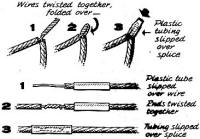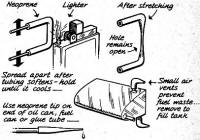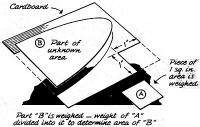|
Here are another seven hand-dandy
tricks of the aeromodelling trade. As with many of the tips and kinks offered by readers of
the era, some - if not most - involve materials and/or methods that have long ben replaced
by more modern means. Still, you might find something useful in the extensive collection from
vintage American Modeler and Air Trails magazines (see list at bottom).
Sketchbook
 William Gilgore of Hellam, Pennsylvania, adds perfect
fillets to models by applying ready-made leather fillet straps as used by patternmakers. Sizes
range from 1/8 to 3/4 inch. Strips add strength. William Gilgore of Hellam, Pennsylvania, adds perfect
fillets to models by applying ready-made leather fillet straps as used by patternmakers. Sizes
range from 1/8 to 3/4 inch. Strips add strength.
 Wires twisted together, These quick and simple wiring
splices are next best thing to a soldered joint. Firmly twisted wires are covered by tight-fitting
plastic tubing. Contributed by Thomas Pinto of Staten Island, New York. Wires twisted together, These quick and simple wiring
splices are next best thing to a soldered joint. Firmly twisted wires are covered by tight-fitting
plastic tubing. Contributed by Thomas Pinto of Staten Island, New York.
 Japanese modeler K. Wakatsuki, Toyko, submits his
method of stretch-forming canopies, wheel fairings, etc., of celluloid or plastic. Important
to secure sheet firmly over face of cut-out. Japanese modeler K. Wakatsuki, Toyko, submits his
method of stretch-forming canopies, wheel fairings, etc., of celluloid or plastic. Important
to secure sheet firmly over face of cut-out.
 The precision free-flight flyer will appreciate tip
sent in by Harry Murphy, Jr. of Anderson, Indiana. Screw adjustment allows close trim of stab
tilt for precise glide turn control. The precision free-flight flyer will appreciate tip
sent in by Harry Murphy, Jr. of Anderson, Indiana. Screw adjustment allows close trim of stab
tilt for precise glide turn control.
 Hang on to used "TV Dinner" trays; use them to wash
model engine parts says Michael Elliser of Bayside, New York. Loosen most dirt in first and
second baths, final rinsing in clear third one. Hang on to used "TV Dinner" trays; use them to wash
model engine parts says Michael Elliser of Bayside, New York. Loosen most dirt in first and
second baths, final rinsing in clear third one.
 After discovering that neoprene tubing could be heated
and stretched to small diameters, George Holeton of Calgary, Alberta, Canada, used tapered
tubes for various model uses. After discovering that neoprene tubing could be heated
and stretched to small diameters, George Holeton of Calgary, Alberta, Canada, used tapered
tubes for various model uses.
 Simple solution to knotty problem by. Richard Miller,
New York City. Area of irregularly shaped part can be determined closely by comparing weight
of pattern with known weight of square inch part. Simple solution to knotty problem by. Richard Miller,
New York City. Area of irregularly shaped part can be determined closely by comparing weight
of pattern with known weight of square inch part.
Got a new idea for construction, adjustment or operation of model planes. boats or R/C?
"AM" pays $10 for each "hint & kink" used. Send rough sketch and description to Sketchbook.
c/o American Modeler, 575 Madison Ave., New York 22, N. Y. Please note that because of the
very large number of submissions, none can be returned to the sender.
Posted July 22, 2017
|